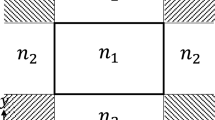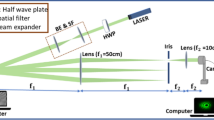Abstract
The beam mode expansion method is adapted to analyze the radiation of a corrugated conical horn without any restriction due to the balanced hybrid conditions, assuming an hybrid modal (HE11)feed. The fields are first calculated on the horn’s aperture and then transformed in a modal expansion. The approximations are discussed and illustrated with computer simulations. Achieved results are finally presented to show the interest of this method.
Résumé
La méthodebme (beam mode expansion) est adaptée à l’analyse du rayonnement d’un cornet cylindrique rainure hors régime d’équilibre hybride, dans l’hypothèse d’une excitation par le mode hybridehe 11. Le champ sur l’ouverture du cornet pour obtenir une expression exploitable, dans le cas général, est calculé ainsi que le rayonnement dans un formalisme vectoriel multimodal. Les approximations faites dans ces développements sont justifiées a posteriori sur des résultats de simulation. Enfin les résultats que l’on peut attendre de cette nouvelle analyse sont exposés.
Similar content being viewed by others
References
Clarricoats (P. J. B.), Olver (A. D.). Corrugated horns for microwave antennas.Peter Peregrinus Ltd., London (1984), pp. 58–62, pp. 128-135, pp. 114-123.
Behe (R.), Bills (R.), Brachat (P.), Dedeban (C), Desvilles(J. L.). Simulation and optimisation software for axisymetrical radiating structures.Ann. Telecommunic. (1994),49, n° 9-10, pp. 575–588.
Aubry (C), Bitter (D.). Radiation pattern of a corrugated conical horn in terms of Laguerre Gaussian functions.Electron. Lett. (1975),11, pp. 154–156.
Wylde (R. J.). Millimetre-wave Gaussian beam-mode optics and corrugated feed horns.IEE Proc. (Aug. 1984),131, Pt. H, n° 4.
Wylde (R. J.), Martin (D. H.). Gaussian beam-mode analysis and phase-centers of corrugated feed horns.IEEE Trans. MTT (Oct. 1993),41, n° 10.
Abramowitz (M.), Stegun (I. A.). Handbook of mathematical functions.Dover Publications Inc., New York, 5th printing, p. 358, p. 331.
James (G. L.). te11 to he11 mode converters for small angle corrugated horns.IEEE Trans. AP (Nov. 1982),30, n° 6, pp. 1057–1062.
Thomas (B. M.), James (G. L.), Greene (K. J.). Design of wideband corrugated conical horns for Cassegrain antennas.IEEE Trans. AP (June 1986),34, n° 6, pp. 750–757.
Dragone (C.). Characteristics of a broadband microwave corrugated feed : a comparison between theory and experiment.Bell System Tech. Journal (July–Aug. 1977).
Pascal (O.), Lemaître (F.), Soum (G.). Paraxial approximation effect on a dielectric interface analysis.Ann. Telecommunic. (1996),50, n° 5-6, pp. 206–218.
Korn (G. A.), Korn (T. M.). Mathematical handbook for scientists and engineers.Me Graw-Hill, New York (1968), pp. 849–857.
Siegman (A.). Lasers.University Science Books (1986), pp. 782–785.
Goldsmith (P. F.). Quasi-optical techniques at millimeter and submillimeter wavelengths, in Button K. (ed). Infrared and millimeter waves.Academic Press (1982),6.
Author information
Authors and Affiliations
Rights and permissions
About this article
Cite this article
Lemaître, F., Soum, G., Pascal, O. et al. Corrugated horn radiation analysis using vectorial Gaussian beam expansion out of the balanced hybrid conditions. Ann. Télécommun. 52, 329–338 (1997). https://doi.org/10.1007/BF02996075
Received:
Accepted:
Issue Date:
DOI: https://doi.org/10.1007/BF02996075
Key words
- Horn antenna
- Corrugated waveguide
- Gaussian beam
- Series expansion
- Hybrid mode
- Multimode waveguide
- Bessel function.




